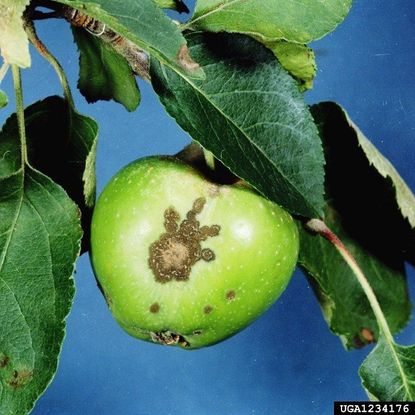Scab On Apple Trees: Identifying And Treating Apple Scab Fungus


Apple trees are an easy-care addition to any home garden. Beyond providing fruit, apples produce beautiful blooms and larger varieties make excellent shade trees if allowed to reach full height. Unfortunately, scab on apple trees is a common and serious problem. Apple tree owners everywhere should read on to learn about controlling apple scab in their trees.
What Does Apple Scab Look Like?
Apple scab fungus infects developing apples early in the season but may not become visible on fruits until they've begun to expand. Instead, apple scab first appears on the undersides of the leaves of the blossom clusters. These fuzzy, roughly circular, brown to dark olive green lesions may cause leaves to distort or crinkle. Scabs can be small and few, or so numerous that leaf tissues are completely covered in a velvety mat. Fruits may be infected at any time from bud set to harvest. Lesions on young fruit initially look much like those on leaves, but soon turn dark brown to black before killing surface tissues, causing a corky or scabby texture. Scabs on infected apples continue to develop even in storage.
Apple Scab Treatment
Apple scab is difficult to control if your tree is already infested, but you can protect future harvests armed with a little apple scab information. Apple scab remains dormant in fallen leaves and on fruit left attached on the tree and lying ground. Sanitation is often enough to control a mild infection; just make sure to burn or double bag all the material to prevent the disease from spreading. When sprays are necessary, they should be applied between bud break and a month after petal fall. In rainy weather, applications every 10 to 14 days may be necessary to prevent apple scab from taking hold. Use copper soaps or neem oil when apple scab is a risk in the home orchard and keep fallen debris cleaned up at all times. If you can prevent apple scab early in the year, it's unlikely to cause you problems as fruits develop. In areas where apple scab is a perennial problem, you may want to consider replacing your tree with a scab-resistant variety. Apples with excellent scab resistance include:
- Easy-Gro
- Enterprise
- Florina
- Freedom
- Goldrush
- Jon Grimes
- Jonafree
- Liberty
- Mac-free
- Prima
- Priscilla
- Pristine
- Redfree
- Sir Prize
- Spigold
- Williams Pride
Gardening tips, videos, info and more delivered right to your inbox!
Sign up for the Gardening Know How newsletter today and receive a free download of our most popular eBook "How to Grow Delicious Tomatoes."

Kristi Waterworth was a regular contributor to Gardening Know How for many years, answering countless queries on plant pests and diseases.
-
 Clever Vertical Vegetable Garden Ideas For Small Spaces – 7 Ways To Save Space
Clever Vertical Vegetable Garden Ideas For Small Spaces – 7 Ways To Save SpaceShort on garden space? Learn some vegetable garden ideas for small spaces that are fun and easy.
By Mary Ellen Ellis
-
 26 Different Types Of Orchids – With Pictures & Information
26 Different Types Of Orchids – With Pictures & InformationDiscover stunning orchid types to grow in your home and garden – from easy beginner varieties to rare and exotic species that are the preserve of experts.
By Melanie Griffiths